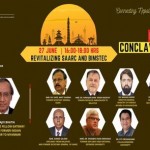These remarks were delivered by the author at the Global Conclave 2021, hosted by the Nepal Institute for International Cooperation and Engagement (NIICE) on 27 June 2021.
A few observations to introduce the subject of the session and to situate our dialogue in the current context.
Our two institutions – SAARC and BIMSTEC – represent important facets of regional and sub-regional cooperation and integration. The realization that integration in South Asia and also between a part of it and a small part of Southeast Asia i.e., Myanmar and Thailand are still at a modest level, is an open secret. We are here, I think, to reflect on its present state, its past trajectory, the challenges and opportunities we perceive in the future as well as to suggest ideas how to strengthen the cause of security, peace and prosperity in this part of the world.
Launched in 1985, SAARC progressed well and began to show much promise in the early years of this century. Between 1985 and 2014, it held 18 summits, with an average of a summit every 1.5 years. Since 2014, that is, for nearly seven years, no summit has been held for the reasons known to us all. The absence of political direction has slowed down the blossoming of the SAARC movement, complete with its elaborate architecture comprising the Secretariat, specialized bodies, regional centers and other programmes. The current situation is obviously not in the region’s interest. What are our options? What do our panelists see happening in the future?
BIMSTEC, established in 1997, held four summits between 2004 and 2018, thus clocking an average of a summit in 3.5 years. The next summit is likely to take place later this year. The foreign ministers, who met in April, have prepared an ambitious package of decisions including a brand-new Charter, a Masterplan for Transport Connectivity and several agreements. But hesitancy persists on expanding cooperation in the realm of trade and goods, services and investment through a comprehensive FTA. Besides, there are political and diplomatic challenges such as the disturbing post-coup developments in Myanmar, tensions in Bangladesh-Myanmar relations, and China’s growing intrusion into the geopolitical and geo-economic space of BIMSTEC. The last-mentioned factor applies to SAARC too. What kind of a future awaits BIMSTEC which is generally considered to have immense potential for growth?
One more question: does the region need only one of the two groupings, or does it need both? And do we not need to revitalize both of them?
Watch the event here.
Ambassador Rajiv Bhatia is Distinguished Fellow, Foreign Policy Studies Programme, Gateway House.
For interview requests with the author, or for permission to republish, please contact outreach@gatewayhouse.in.
© Copyright 2021 Gateway House: Indian Council on Global Relations. All rights reserved. Any unauthorized copying or reproduction is strictly prohibited


